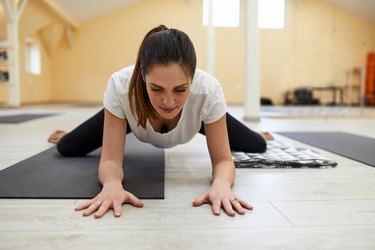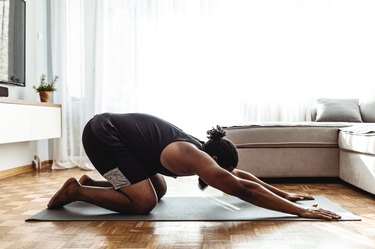
Frog pose (Mandukasana) is a hip-opening posture in yoga. In this shape, you're on the ground resting on your knees and forearms with your knees out wide. The pose may look simple, but it's one of the more advanced hip-opener poses that many people find difficult to do.
Frog pose has many benefits, especially for the inner thighs and groin. That said, it gets intense pretty quickly. To practice frog posture safely, you'll need to warm up and use proper form. Below, we'll share how to do it.
Video of the Day
- What is frog pose? Frog pose is an intense hip-opening posture in yoga. "Mandukasana," the Sanskrit name for the posture, literally translates to "frog pose," which signifies the frog-like shape your body takes in the pose.
- What is frog pose good for? Frog pose targets your hips, inner thighs and groin and also opens up your chest and shoulders. Traditionally, frog pose is said to promote good circulation, healthy digestion and upright posture.
- Who can do frog pose? Frog pose may be difficult for some people especially if your inner thighs and/or hips are very tight. Don't do frog pose if you're pregnant, have a back, hip or knee injury or have had a recent surgery involving your abdomen, chest, shoulders, knees or legs.
- How long should you hold frog pose? Hold frog pose anywhere from 3 full breath cycles to 10 full breath cycles. You may practice frog pose in a yin yoga class, where postures are held for up to 5 minutes.
- Why is frog pose so difficult? Frog pose can be difficult if your inner thigh muscles (like your adductors or pectineus) are very tight. The same goes if your hips are tight, which can be common if you spend long periods of time sitting down.
How to Do Frog Pose With Proper Form
- Begin in a tabletop position on your hands and knees. Your shoulders should be stacked over your wrists and hips stacked over your knees, and your core should be engaged (think of pulling your lower belly up and in). Take a few breaths in this position.
- Take a deep inhale, then begin to slowly move your knees out toward the sides (away from each other).
- Whenever you start to feel sensation in your inner thighs and groin, stop and exhale to allow your muscles to relax. Don't continue to move your knees outward if you're feeling pain.
- Turn your feet out toward the sides so the inner edges of your feet, ankles and knees are touching the ground. Keep your feet flexed to support your ankles. Keep your ankles in line with your knees, so as to avoid turning this into child's pose.
- Take another deep inhale and slowly lower down onto your forearms. You can place your palms flat down or press them together. If it feels too intense to come down to your forearms, you don’t have to. Remain upright with your arms straight, or place your forearms onto blocks.
- Stay in the posture and breathe for 3 to 10 full breath cycles. This posture gets more intense the longer you hold it, so you may not want to stretch to your full capacity at the very beginning. Use your breath as a guide. If you’re holding your breath or cannot take full deep breaths comfortably, you’ve likely gone too far.
- To come out of the pose, take a deep inhale and on your exhale, slowly walk your knees back in together, eventually returning to your tabletop position.
Tip
Place a folded blanket or towel (or double up your mat) under your knees for more cushion, which can make the posture more comfortable.
Benefits of Frog Pose
1. It Stretches Your Hips and Thighs
The main benefits of frog pose are that it deeply stretches your hips, inner thighs and groin area, which may become tight from activities like sitting for long periods of time. It can increase circulation in these areas and improve your overall hip mobility.
Hip mobility is especially important as you age and your risk of experiencing hip pain, fractures and falls increases, according to the Centers for Disease Control and Prevention (CDC). Hip mobility also important for proper activation of the opposing muscles such as the glutes.
2. It Relaxes Your Pelvic Floor
Your pelvic floor is a group of muscles that sits at the base of your pelvis, and they play an important role in functions like digestion and urinary and fecal continence. Modern lifestyles that require lots of sitting can often lead to tightness in this area.
Frog pose offers a deep stretch to this delicate group of muscles. Keeping it flexible may help you avoid issues like urinary and fecal incontinence and constipation, according to the National Association for Continence.
3. It Releases the Tension in Your Lower Back
Most hip-opening postures have benefits for the lower back as the muscles in the hips and lower back are intricately connected. Tight muscles in the hips can lead to lower back stiffness and pain.
And, stretching the hip flexors has a positive effect on back pain and stiffness, according to a February 2021 research review in the International Journal of Environmental Research and Public Health.
After practicing frog pose, you'll probably notice that your lower back feels nice and open.
4. It Relieves Stress
Many people hold on to stress in different parts of their body, such as their shoulders and hips. Practicing yoga poses, especially when you're holding the pose for a few long, deep breaths or even longer (like in a yin yoga class) may help with lowering your stress and anxiety levels, according to Harvard Health Publishing.
Common Mistakes in Frog Pose
1. Going Further Than Your Flexibility Allows
Taking your knees too far apart (i.e. further than your flexibility allows) can cause pain and injury. In an advanced posture like frog pose, it's important to listen to your body and not force your knees apart beyond where it is comfortable.
As we mentioned, this pose gets more intense the longer you hold it, so don't go to your edge right away. If you're holding your breath, you've probably gone too far — slowly bring your knees in closer until you can breathe comfortably.
2. Arching Your Lower Back
It's important to keep your core engaged by pulling your lower belly up and in to support your lumbar spine (aka your lower back). Otherwise, you may notice your lower back arching, which can cause pain or injury.
Try to imagine that you're stretching your tailbone back behind you and pressing your sternum and crown of your head toward the front of your mat to keep your spine long.
Frog Pose Variations
If frog pose feels too intense, take your knees closer together to start. You may want to stay up on your hands with your arms fully extended before coming down to your forearms.
You can also add a yoga block underneath your hands (with your arms extended) or under your forearms to bring the ground closer to you, which may help ease your body into the pose.
How to Add Frog Pose to Your Yoga Practice
Before practicing frog pose, it's important to properly warm up the muscles in your hips and groin. You can start with three rounds of sun salutations to get your blood flowing, and practice a few warmup poses like:
- Wide-legged child's pose (Balasana)
- Butterfly pose (Baddha Konasana)
- Wide-legged forward fold (Prasarita Padottanasana)
- Yogi squat (Malasana)
- Warrior II pose (Virabadrasana I)
- Extended side angle (Utthita Parsvakonasana)
- Hero pose (Virasana)
- Pigeon pose (Eka Pada Rajakapotasana)
Just as well, you'll want to practice a few of these counter poses to balance and relax your body after doing frog pose:
- Wide-legged child's pose
- Supine twist (Jathara Parivartanasana)
- Wind-relieving pose (Apanasana)
- Happy baby pose (Ananda Balasana)
And as always, seal the benefits of your practice with a relaxing Savasana.
More Yoga Poses We Love
- Harvard Health Publishing: "Yoga for Better Mental Health"
- International Journal of Environmental Research and Public Health: "The Influence of Stretching the Hip Flexor Muscles on Performance Parameters. A Systematic Review with Meta-Analysis"
- National Association for Continence: "How to Relax Your Pelvic Floor"
- CDC: "Hip Fracture"



